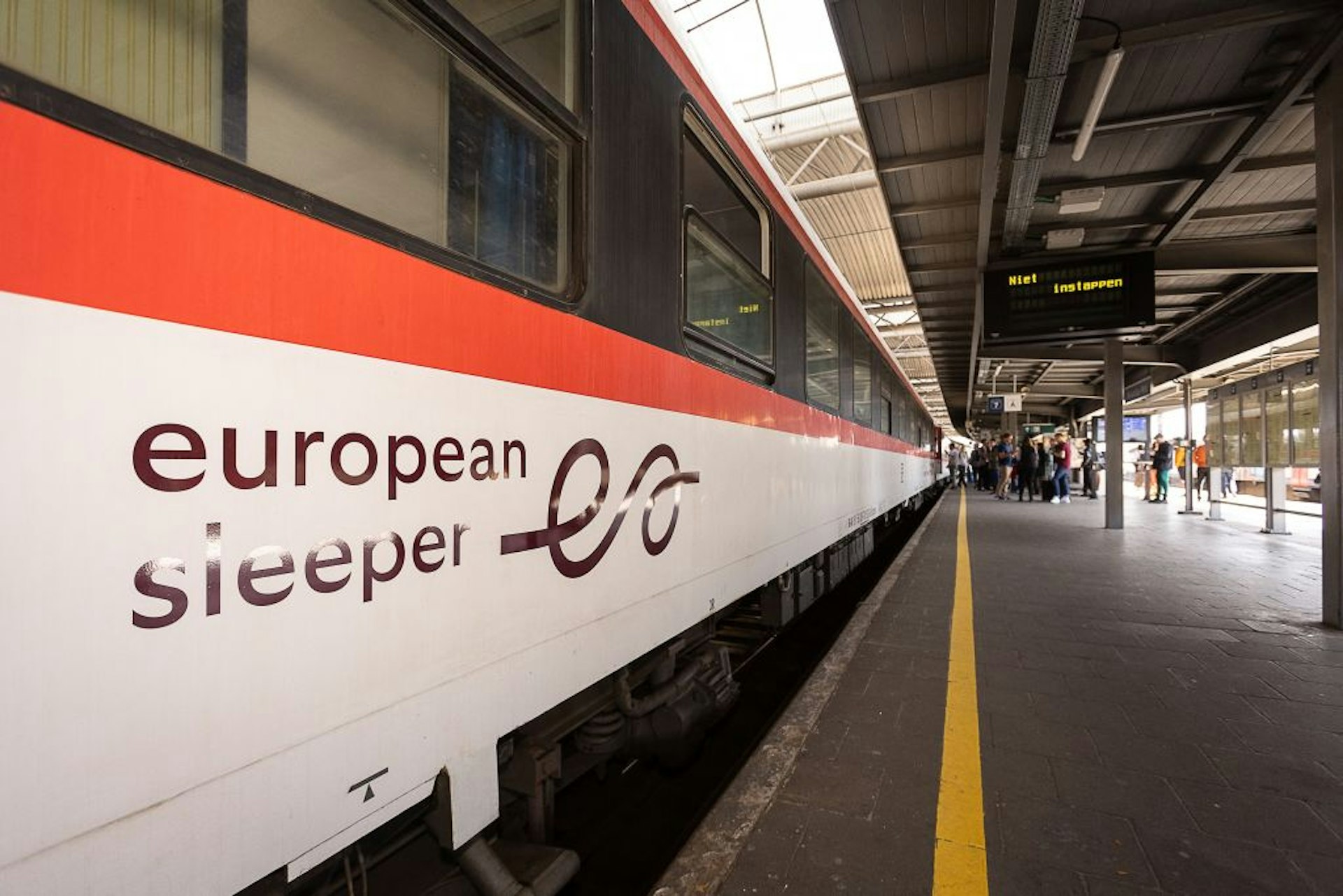Two years in the making, the first Brussels-Berlin sleeper train is finally here. Monisha Rajesh rode the inaugural twilight train through Flanders’ open fields and forests.
In late 2020, two railway fans came together in the hope of pumping life back into the slowly dying category of sleeper trains. What started as little more than a mutual love of nighttime travel inspired them to found the Belgian-Dutch collective European Sleeper. Together, they sourced and refurbished old rolling stock – Slovak and German coaches built in the mid 1950s – and mapped out a route from Brussels to Berlin via Antwerp, Rotterdam and Amsterdam. The first train departed Brussel-Zuid station last month, and now runs every Monday, Wednesday and Friday. The return leg operates Tuesdays, Thursdays and Sundays.
The resurgence in sleeper trains across Europe and climate-change concerns meant it didn’t take a lot to tempt passengers on board the first 400 seater trip. The train left the station to much fanfare and traveled out over graffiti-covered bridges toward Flanders’ open fields and forests.

Air conditioning not as standard
The absence of air conditioning made for a stifling ambiance in the sleeper compartments, which each contained a trio of made-up beds with heavy duvets, a single seat and table, and a hidden wash basin that opened like a drinks cabinet. A grunt and a shove got my window down a few inches – but most passengers stood in the corridor, relishing the rush of wind through one large open window and basking in the glow of the dipping sun as it bounced across waterways toward the city of Dordrecht, where windmills turned slowly, and houseboat masts lined up.
While there was no dining car on board, an attendant went back and forth taking orders for wine, beer, nachos and instant noodles (all reasonably priced). Having wolfed down a plate of boudin noir and mash at long-standing Brussels brasserie Au Vieux Saint Martin, I was sated and perfectly happy to wander about with a tube of Pringles under one arm and a can of European Sleeper’s own Weizen beer. I chatted with passengers traveling in the couchette compartments on what was beginning to feel like a bit of a party train (one that dogs and cats are also welcome on, provided private compartments are booked out).

Couchette or sleeper carriage?
Although couchettes (carriages with seats that convert into sleeping berths) are the cheaper option (€79) when compared with sleeper compartments (€109), so ample was the space that the couchettes each felt like a small living room, with six or four comfortable berths topped with folded blankets, a sheet and a pillow. Here, the windows were shoved right down with wind blasting through as the train raced through the countryside (though the wind was billowing with so much pollen that antihistamines were being shared like sweets).
With little to do once the initial buzz had settled, most passengers started swapping train stories. Some gathered to watch a football match being streamed on a laptop, while others drank as though the end was nigh. It felt like we’d gathered together for one night as a train family, comfortable with strangers – strangers, that is, who shared a mutual love of trains.

Darkness swept in after Rotterdam, and we drew into Amsterdam as brightly lit commuter trains flashed the other way and smart apartment buildings rolled by, curtains open to reveal residents working their desktops or reaching for books on shelves. It’s this glimpse into other people’s intimacies that makes night trains so fulfilling: watching a cat pick its way across the top of an armchair, or a woman hugging a partner in their kitchen, oblivious to the watchful eye flashing past.
Stepping back from the window, I could smell a dwindling odor of wine and beer, and the final footsteps up the corridor signaled that everyone else had taken to their berths. While rattle-proofing the compartment, I noticed my neighbors’ ladder thumping against the wall, as though someone was knocking at the door. And that was it for me.

What type of breakfast is served
The rest of the night was spent awake, pillow on head, wishing I’d packed earplugs. Were it not for the torturous banging, the ride was smooth, even gentle. I dozed off in the small hours, waking at 5am in the town of Peine in Lower Saxony, where an anemic blue sky was beginning to turn orange, and an icy-looking mist hovered above the fields.
After snatching a couple more hours’ sleep, I woke to morning clamor on the approach to Berlin. As I rummaged through my breakfast box (included in the price of the ticket), I decided that it was a bit too early for crackers and Ardennes pâté. It was just before 8am, and those who’d slept well were discussing heading straight into the city for breakfast to get a swift start on seeing the sights before the crowds.
Despite the odd niggle – the electricity had stopped before Germany and no one’s phones would charge through the evening – the train had more than delivered on expectations, depositing a fleet of happy passengers into the German capital with little delay.
How to book the Brussels to Berlin night train
Running Mondays, Wednesdays and Fridays, the train departs at 6pm, arriving in Berlin just before 7am. The reverse journey runs on Tuesdays, Thursdays and Sundays, from Berlin-Lichtenberg to Brussels – though this should eventually move to Berlin Hauptbahnhof once engineering works are completed. Seats begin at €49, couchettes at €79 and sleepers at €109. Pets and bikes can be accommodated. Book in advance here.














